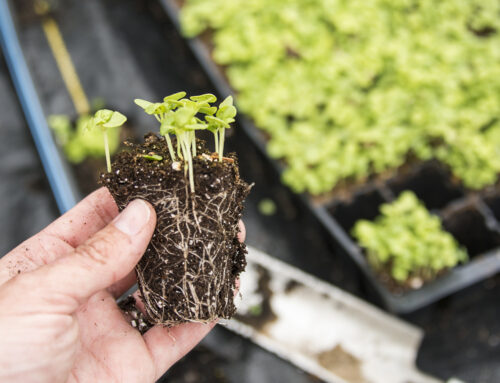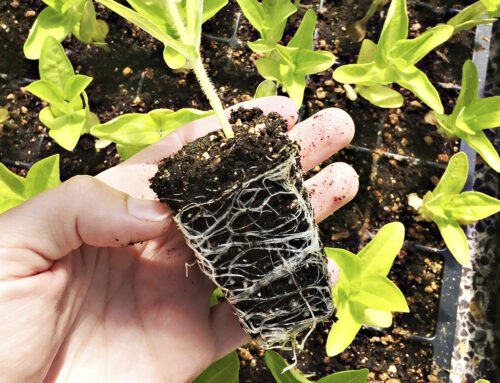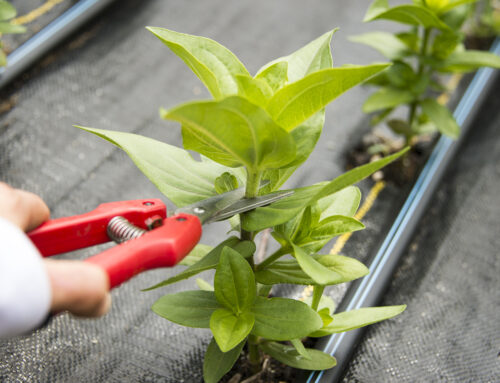I have a serious need for seed! I’m a seed saver. Always have been. Always will be. Some seeds have a great shelf life, while others do not. Which is why it’s so important to do a quick seed viability test every year with any leftover seed I plan to use in the garden.

Seed Viability:
Seed viability refers to the ability for your seed to germinate and produce plants. Each seed has their own germination rates, and these decrease over time. Storing your unused seed in a cool, dry space is optimal, and will improve it’s viability.
Keeping leftover seed in a cool room (around 42ºF) with low humidity will increase its viability and longevity. Including a desiccant (those little packets of silica you get in various products like purses and boxes) will help control the humidity.

Maximize your seed longevity by saving seed packets in sealed glass jars (along with a desiccant packet) in the refrigerator. Remember to allow your seed jars time to warm up to room-temperature before opening, otherwise the condensation will create unwanted moisture and your seeds will soak in the water and clump together.
Unfortunately my seed stash is too big for the fridge. Instead, I opt for tin boxes with desiccant and store in our basement guest room to keep them cool and humid-free. This has been successful for me for years.
Knowing the viability stats will help you identify which seed has a good chance or germinating, and which it may be too late for.
Use the lists below (located at the bottom of the post) for seed storage guidelines, or download my free Guide for Seed Storage PDF HERE to identify which seed is good to go, and which to chuck.

As a frugal gardener I never want to waste seed, so for seed that is at, near,—or even past—its sell-by date I do a quick viability test. Usually I’m pleasantly surprised with higher than expected germination more often than expected!
Easy Seed Viability Test: Step-by-Step:
Step 1:
Grab your seeds, some paper towels (which I know are a hot commodity in these coronavirus days), ziplock sandwich bags and a sharpie marker.
Step 2*:
Using the sharpie, note the date and seed name on each ziplock bag. I also like to include the expected germination time as a benchmark. Use one bag for each plant variety.

* You can also do this using one long strip of paper towels with ID tags and plastic cling wrap. I prefer to do them separately in sandwich bags by variety.
Step 3:
I use the select-a-size, so I’m able to tear off a sheet of paper towel and fold it in half to comfortably make a square of paper towel that will easily fit into the baggie.
Step 4:
Then I slightly dampen the paper towel square with water and place it evenly in the sandwich bag. Soaking wet paper towels can rot the seed.
Step 5:
Place several seeds (ideally 10) of each questionable variety between the folded paper towel layers, in their respective bags and seal.
Step 6:
Place the seed testing bags in a warm (70ºF or warmer), and sunny (if you have it) location. Warm windowsills are great.
If you don’t have a bright place don’t worry about the light, it isn’t a crucial component. Just place them in a toasty spot—like the top of your fridge.
Step 6: Monitoring
Check your seeds every few days. Each seed packet lists the germination time, this will give you an idea of when you should see some seed sprouting! If you don’t know the days for germination, check in 7-14 days.
The first sign of life is root development, which can usually be seen through the paper towel.

Germination has begun!
Once you see roots or green sprouts, you’ve got germination! Take a peek at the entire bag of seeds. This will give you a good idea of what you can expect your germination rate to be. For example, if five or your 10 seeds sprout, you can expect to have 50% of those seeds to germinate. If three grow roots, then you have a 30% germination rate. So now you’ll have a good idea of how many seeds from that packet will grow into healthy plants.
Now don’t go throwing out the germinated seeds! That would be wasteful. Simply cut out the rooted seed with paper towel attached, and plant in a soil-filled pot—paper towel and all!
Larger seeds, like peas and beans, can be tested using the water method. When good seed is placed in a bowl of water, they’ll sink. If they float, trash them. I like to give them 5-10 minutes.

Now, go and dig out any old seed you’ve got, test it out and and see what’s growing!
And if you’re ready to get growing, check out my posts where I share with you all about how I Plan my Garden, and figure out my Sow Schedule and Plant Spacing.
Seed Storage Guide: (in years)
Vegetables:
- Artichoke + Cardoon..1-4
- Asparagus …………….. 3-4
- Beans ……………….….. 2-4
- Beets ……………..…….. 2-5
- Broccoli ………….……..3-5
- Brussels sprouts …….3-5
- Cabbage ………………..3-5
- Carrots ………………….3-4
- Cauliflower ……………4-5
- Celery + Celeriac ….. 3-5
- Chicory………………….4-5
- Collards ………………..3-5
- Corn (sweet) ………….1-3
- Cress …………………….5
- Cucumber …………….3-6
- Eggplant ………………4-5
- Endive ………………….5
- Kale ………………….….3-5
- Kohlrabi ……………….3-5
- Leeks ……………………2-3
- Lettuce …………………1-6
- Melon …………………..3-6
- Onion …………………..1-2
- Parsnip ………………..1-3
- Peas …………………….2-4
- Peppers ……………….2-5
- Pumpkin ……………..4-6
- Radish …………………4-5
- Rhubarb ………………1-2
- Rutabaga ……………..3-5
- Spinach ……………….1-5
- Squash + Gourds ….3-6
- Swiss chard ………….2-5
- Tomato ………………..3-7+
- Turnip …………………3-5
- Watermelon………….4-5
Herbs:
- Angelica ………………2
- Anise …………………..1-3
- Basil ……………………3-5+
- Bergamot …………….4
- Borage …………………1-4
- Calendula …………….4-6
- Caraway ……………….1-2
- Cardoon …………….…1-4
- Catnip ………………… 3
- Celery Leaf …………..3-5
- Chamomile …………..4
- Chervil …………………1-4
- Chives ………………….1-3
- Cilantro/Coriander..1-4
- Cumin ………………….1-3
- Dill ………………………1-4
- Epazote ………………..3
- Fennel ………………….1-2
- Fenugreek …………….5
- Hyssop …………………1-4
- Lavender ………………4
- Lemon Balm …………1-4
- Lemon Grass …………3
- Lovage ………………….1-3
- Marjoram ……………..1-4
- Mexican Marigold…..4
- Mint* ……………………4
- Mustard Seed ………..3-5
- Nasturtium ……………3-7
- Oregano …………….….4
- Parsley ………………….1-4
- Papalo …………………..1
- Rosemary ………………1-4
- Sage ………………………1-3
- Savory ………………….. 1-4
- Shiso ……………………. 2-4
- Stevia …………..…….….2
- Soapwort ……………….2-5
- Sorrel …………………….3-5
- Sweet Cicely ……………1-2
- Thyme ……………………1-4
- Wormwood ……………..1-5
Flowers:
- Ageratum ………………3-5
- Alyssum ………………..3-5
- Ammi ……………………2
- Amaranthus …………..4-5
- Aster ……………………..1-2
- Baby’s Breath …………2-4
- Bachelor’s Buttons…..2-5
- Bells of Ireland ……….2
- Butterfly Weed …..…..1
- Campanula …………….3
- Carnation ………….…..3-5
- Celosia …………….…….2-4
- Chinese Lantern ….….1
- Chrysanthemum ….…3
- Columbine ……………..1-2
- Coneflower …………….1-2
- Coreopsis ……………….2
- Cornflower ……………..1-5
- Cosmos ………………… 3-5
- Dahlia ……………………2-5
- Daisy ……………………. 3
- Delphinium ……………1-3
- Dianthus ………………..3-5
- Dusty Miller ……………3-5
- Echinacea ……………….4
- Eryngium ………………..2
- Eucalyptus ………………4
- Euphorbia ……………….4
- Feverfew …………………1-3
- Forget-Me-Nots ……….2
- Foxglove …………………1-2
- Glove Amaranth …..….3-5
- Hollyhock ……………….3
- Honesty ………………….2
- Hyacinth Bean Vine …3-5
- Impatiens ……………….1-2
- Laceflower ………………2
- Larkspur …………………1-3
- Lisianthus ……………….2-3
- Lupin …………………….. 3-5
- Marigold ………………… 2-5
- Morning Glory ……..…..2
- Nasturtium ………………3-7
- Nicotiana …………………3
- Nigella …………………….3-5
- Pansy ………………………1-2
- Petunia ……………………5
- Phlox ………………………1-3
- Poppy ……………………..2-4
- Rudbeckia ……………….1-2
- Salvia ………………………1-3
- Scabiosa ………………….2-5
- Snapdragon …………….3-5
- Statice …………………….1-2
- Stock ………………………4-5
- Strawflower ……………..1-2
- Sunflower ………………..3-5
- Sweet Pea ………………..3-5
- Tithonia …………………..2
- Verbena …………………1-5
- Viola ……………………..1-2
- Yarrow …………………..3-5
- Zinnia …………………….2-5





[…] a viability test (Check out the blog post of Seed Viability Testing HERE!) on any old seed that you’re concerned may not […]